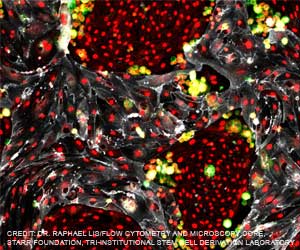- Scientists have isolated a self-renewing and multipotent human skeletal stem cell (hSSC) that generates progenitors of bone, cartilage, and stroma, but not fat
- The stem cells can also be generated from blood cells and fat cells
- The new discovery could pave the way to develop new treatments for regenerating bone and cartilage in people
"Every day children and adults need normal bone, cartilage and stromal tissue," said Michael Longaker, MD, professor of plastic and reconstructive surgery. "There are 75 million Americans with arthritis, for example. Imagine if we could turn readily available fat cells from liposuction into stem cells that could be injected into their joints to make new cartilage, or if we could stimulate the formation of new bone to repair fractures in older people."
The study is published online in the journal Cell.
Skeletal Stem Cells vs Mesenchymal Stem Cells
Mesenchymal stem cells can be isolated from blood, bone marrow or fat. They can generate skeletal tissues, fat and muscle. Some clinicians consider them all-purpose stem cells. They have not been very successful in clinical trials and their ability to regenerate a variety of tissues has not been proved in experimental treatments.Three years after discovering skeletal stem cells in mice, the same set of Stanford scientists have now discovered the human version of the skeletal stem cell (SSC), which will be used as the precursor to bone, cartilage and stroma, the bone marrow’s support cells. The human stem cells possess all of the hallmark qualities of true, self-renewing, multipotent and tissue-specific stem cells.
Adult stem cells unlike embryonic stem cells make progenitor cells that give rise only to the types of cells that naturally occur in that tissue – this quality is termed as lineage-restricted. Hence, in the case of the skeleton, the stem cells will make only bone, cartilage and stroma.
Study
The researchers started with a human fetal femur which is the thighbone. They used a technology called fluorescence activated cell sorting to separate cells present in areas of active growth in the fetal bone, based on the expression of proteins on their surface.They found four markers or proteins PDPN, CD146, CD73, and CD146, none of which were shared with mouse SSCs. The team hypothesized that the presence or absence of the four markers could define skeletal stem cells.
A point to note is that the human SSCs could grow into bone, cartilage, and stroma, the three main lineages that comprise the human skeleton, but not fat or adipose cells showing that these stem cells are specific to the skeleton.
The cells are found at the end of developing bone, as well as in increased numbers near the site of healing fractures. They can also be generated by reprogramming human fat cells or induced pluripotent or immature stem cells to assume a skeletal fate.
The skeletal stem cells also provided a nourishing milieu for the growth of stem cells in the bone marrow that develop into the blood and immune system cells (hematopoietic stem cells) without the addition of extra growth factors.
"Blood-forming stem cells love the interior of spongy bone. It's the perfect niche for them. We found that the stromal population that arises from the skeletal stem cell can keep hematopoietic stem cells alive for two weeks without serum" said Charles K.F. Chan, PhD, assistant professor of surgery and a lead author.
The researchers also managed to create a kind of family tree of skeletal stem cells which were important to the development and maintenance of the human skeleton, and that could serve as a foundation for further studies into potential clinical applications.
The ultimate aim of the researchers is to find a way to use the human skeletal stem cells in the clinic.
"I would hope that, within the next decade or so, this cell source will be a game-changer in the field of arthroscopic and regenerative medicine," Longaker said. "The United States has a rapidly aging population that undergoes almost 2 million joint replacements each year. If we can use this stem cell for relatively noninvasive therapies, it could be a dream come true."
Reference:
- C. K. F. Chan, Sinha R, et al. Identification of the human skeletal stem cell. Cell. (2018). doi: 10.1016/j.cell.2018.07.029
- Skeletal stem cells discovered in humans (https://www.bionews.org.uk/page_1385883)
- Stem cells (http://www.whatisbiotechnology.org/index.php/science/summary/stem/stem-cells-repair-tissues-and-regenerate-cells)
Source-Medindia













